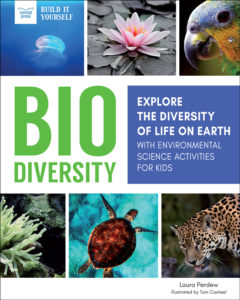“Celebrate Biodiversity: Life + Variety = Biodiversity”
From smelly stinkhorn mushrooms to hardy tardigrades, and towering sequoia to soaring condors, and creepy anglerfish to the Hercules beetle, Earth is home to MILLIONS of known species of plants, animals, fungi, bacteria, and microorganisms of all shapes and sizes. Scientists estimate there could be millions (if not billions) more species that have not yet been identified.
Biodiversity is present everywhere on the planet including some pretty extreme places: near volcanoes, at the deepest parts of the ocean, in the sand, in hot springs and mud pots, in the ice, and even under the ice. And consider this – wherever you are at this moment you are in the company of hundreds or maybe even thousands of other species growing, squiggling, flying, reproducing, wriggling, feeding, and thriving.
Biodiversity: Explore the Diversity of Life on Earth explores genetic, species, and ecosystem biodiversity and how each species, no matter how large or how small, has a role to play. It is all CONNECTED. As John Muir once wrote, “When we try to pick out anything by itself, we find it hitched to everything else in the Universe.”
These interconnections make our planet mighty, yet also fragile and vulnerable. Writing and researching Biodiversity gave me an increased appreciation for the amount, variety, and complexity of life on our planet. Unfortunately, I am also now even more aware of the many threats to biodiversity. The time for action is now. To quote Dr. Seuss, “Unless,” he wrote in The Lorax in 1971, “unless someone like you cares a whole awful lot, nothing is going to get better, it’s not.”
My hope is that the book will inspire wonder in kids and raise awareness.
Wonder leads to caring (hopefully a lot!).
And if kids care, they will act.
Starred review from Booklist:
“By book’s end, readers will truly understand what biodiversity is, its importance to the health of the planet, and humans’ impact on the complex natural systems where it thrives.”
Activity: Explore Biodiversity
To start the discussion about biodiversity, generate a list as a group of five examples of each of the following: plants, animals, fungi, bacteria, and microorganisms. This list will ultimately spark conversations. Next, challenge students to research and discover one species of plants, animals, fungi, bacteria, and microorganisms they’ve never heard of. To generate even more interest, challenge them to find the most unique or bizarre species they can. Their findings can be shared in any number of formats, including a museum-style gallery walk, an online slide show, or a “show and tell.”
Questions for discussion:
- What are the similarities between the all plants discovered? What are the differences?
- What would happen if one of the animals students researched disappeared?
- What role do the fungi play in the ecosystem?
- Bacteria are often thought of as something to get rid of. What do you think the larger results of this might be?
- How do you feel about the microorganisms all around you?
Activity: Get Involved
There are many ways for students to get involved to support biodiversity. One is to protect or create new habitats.
Today, the populations of pollinators are in decline, especially butterflies and bees. Much of this is due to habitat loss and poisoning as a result of pesticide use in agriculture. To support pollinators, conservationists are encouraging people to plant pollinator gardens at home, work, school, and in the community.
Start by identifying a place where kids can plant a garden. If space is an issue, consider using a large pot or a planter outside a window because they will attract pollinators too! The next step is to research the types of pollinators in your area. Then research types of plants that these pollinators are attracted to. Try to find a variety of plants that flower throughout the spring, summer, and fall. Perhaps go talk to a local expert or invite one into the classroom. Draw plans for the gardens and plant in the spring. As the garden grows, record observations about the growth and about the species that visit the garden.
Questions for discussion:
- How many different species have you observed in your garden? Do certain pollinators like specific types of flowers?
- There is a lot going on above the soil. Did you ever consider what is going on below the soil? What kinds of species may be living there? Are they harmful to the garden or helpful?
- What would it take to launch a local effort to create pollinator gardens? Could you educate neighbors about planting their own gardens? Can you convince the school to set aside a larger area for a garden? How about in the community?
Activity: Celebrate Biodiversity!
Understanding and appreciating biodiversity are a critical part of the effort to protect it. Kids can play a key role in raising awareness about the threats to biodiversity. Have kids create a piece of visual art that celebrates biodiversity. It can celebrate the biodiversity around the world, just in your community, unseen biodiversity, or biodiversity in a single ecosystem. Each student should choose their own medium – painting, sculpture, collage, photograph, or whatever interests them. The goal is to create a piece that celebrates the variety and value of life on Earth, and to make others stop to think as well.
Consider places where the artwork can be displayed – in the school, community centers, churches, other gathering places, or even online. Invite family and friends to view the pieces. International Day for Biological Diversity is May 22, but, of course, you can celebrate any day.
Questions for discussion:
- As you worked on your piece, did you slow down and spend more time thinking about biodiversity?
- What was the reaction to the pieces from others?
- Have you been inspired to do even more to raise awareness of the issues facing biodiversity? What else can you do?
More teaching resources for Biodiversity at https://nomadpress.net/wordpress/wp-content/uploads/2018/07/Biodiversity-Classroom-Guide.pdf.
Biodiversity: Explore the Diversity of Life on Earth with Environmental Science Activities for Kids
Author: Laura Perdew
Illustrator: Tom Casteel
Published March 5th, 2019 by Nomad Press
About the Book: From the tallest tree to the smallest microbe, Earth is home to more than 1.5 million known species of plants, animals, fungi, bacteria, and microorganisms. And scientists estimate there could be millions, if not billions, more that have not yet been identified!
Biodiversity: Explore the Diversity of Life on Earth with Environmental Activities for Kids introduces middle schoolers to the evolution of life on Earth, beginning with the first single-celled organisms that emerged 3.8 billion years ago to the complex, multi-celled organisms that exist today and make up the tree of life. Biodiversity is found everywhere on the planet—on land, in the water, and even in extreme environments such as ice and volcanoes. There are actually entire microbiomes beneath our feet, in puddles, and even in our belly buttons!
Biodiversity includes hands-on STEM activities and critical thinking exercises to encourage readers to consider the threat to biodiversity and figure out ways to be part of the solution. Fun facts, links to online primary sources and other supplemental material, and essential questions take readers on an exploration of the incredible biodiversity on Earth.
About the Author: Laura Perdew is an author, writing consultant, and former middle school teacher. She has written more than 15 books for the education market on a wide range of subjects, including the animal rights movement, the history of the toilet, eating local, and the Great Pacific Garbage Patch. She is a long-time member of the Society of Children’s Book Authors and Illustrators. Laura lives in Boulder, Colorado.
Website: lauraperdew.com
Thank you, Laura, for this wonderful post about our amazing Earth!


